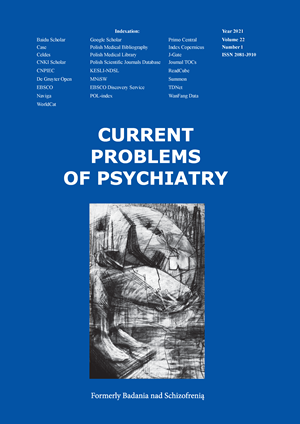Dance and Movement Psychotherapy - description of the method andgroup sessions in General Psychiatric Ward
DOI:
https://doi.org/10.2478/cpp-2021-0001Keywords:
psychotherapy, DMT, LMA, therapy groupAbstract
Introduction: Dance and movement psychotherapy is a psychotherapeutic approach, which assumes that expressive movement can reflect the emotional state of the moving person. It is a method in which movement is supposed to lead to personal integration and development, and the psychotherapist is supposed to create conditions in which emotions can be safely expressed and transmitted, and can meet with acceptance.
Material and method: The aim of this study is to describe a case series of patients treated at the General Psychiatric Ward who participated in group sessions of dance and movement psychotherapy (DMT), and to analyse the impact of psychotherapy on their treatment process. In 2019, 12 patients of the General Psychiatric Ward were included in dance and movement psychotherapy (DMT) sessions. The sessions took place once a week from October 2019 to December 2019 and lasted 1h and 10 min. A common element in movement that could be observed in most people in this group was tense shoulders and free forearms and hands. In addition, it was possible to observe in the group members compact flow, free time, multidirectionality, light weight according to the LMA System. Under the influence of the applied interventions it was possible to observe how the bodies of individual group members relax and their chests open. It was also observed how the participants activated their deep abdominal muscles and settled into the therapeutic space. At the same time it was apparent how the patients became attentive to their bodies and movement, which, in turn, translated into their sense of confidence and reduction in anxiety and tension.
Discussion: The main problem of semi-open groups is the impaired ability to integrate patients and the difficulty in finding trust and a sense of security. In addition, resistance to attachment naturally arises in group members. Patients do not have the opportunity to experience all stages of the development of the therapy group, especially the last one, the phase of ending psychotherapy. Nevertheless, the semi-open therapy group seems to have some advantages and some problems are highlighted, so that psychotherapeutic work on them can be deepened.
Conclusions: Although conducting a group process in a semi-open community is not a comfortable situation for the psychotherapist and the patients due to the difficulty of finding a sense of security and the naturally occurring resistance to attachment, the sessions seem to be very helpful in integrating the patients' community and in dealing with the inner tensions of each member.
References
1. Pędzich, Z. (ed.), Psychotherapy with dance and movement. Individual and group therapy. Sopot: Gdańskie Wydawnictwo Psychologiczne, 2014
2. Czubała, J. C., Czynniki leczące w psychoterapii, Warszawa: Wydawnictwo Naukowe PWN, 1997
3. Payne, H. (red.), Dance movement therapy: Theory, reasearch and practice (wyd. 2). London - New York: Routledge - Taylor & Francis Group, 1992
4. Sachs, C., World history of the dance. New York: W. W. Norton & Co, 1965
5. Levy, F. J., Dance/movement therapy: A headling art. Reston: National Dance Assiciacion, American Alliance for Health, Physical Education, Recreation, and Dance, 1992
6. Payne, H., Supervision of dance movement psychotherapy: A practitioners guide, London - New York: Routledge, 2008
7. Siegell, E. V., Psychoanalytic dance therapy: The Bridge between psyche and soma, American Journal of Dance Therapy, 17(2), 115-128, 1995
8. Meekums, B. , Dance movement therapy. A creative psychoterapeutic approach. London: Sage Publications, 2002
9. Winnicott, D. W., Children and their mothers, Transl. M. Halaba. Warsaw: W.A.B., 1994
10. Galecki P., Szulc A., Psychiatry, edra Urban & Partner, Wroclaw 2018: 160-161
11. Pużyński St., Rybakowski J., Wciórka J., Psychiatria tom 2 -Psychiatria kliniczna, wyd. Elsevier Urban & Partner, Wrocław, 2011: 233-238
12. ICD-10 Classification of Mental and Behavioural Disorders, University Medical Publishing House "Vesalius", Krakow Warsaw, 2000: 50-54
13. Newlove J., Dalby J., Laban for all -Polish translation, Kined Publishers, Warsaw, 2011: 121-140
14. Winnicott D.W., Play and reality, Imago Publishers, Gdańsk, 2011: 82-96
15. Barbara A., Applications of Laban Movement Analysis: An Integrated Approach to Voice, Speech and Movement Training for Actors, Journal of Laban Movement Studies, New York, 2008
16. Yalom I., Group Psychotherapy -Theory and Practice, Jagiellonian University, Krakow, 2006
Downloads
Published
Issue
Section
License
Copyright (c) 2021 Authors

This work is licensed under a Creative Commons Attribution 4.0 International License.


